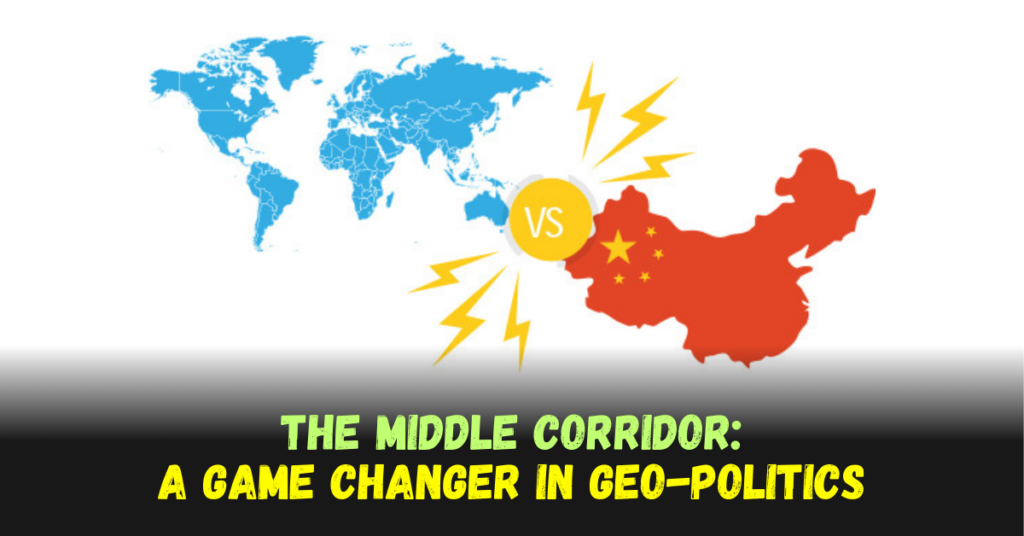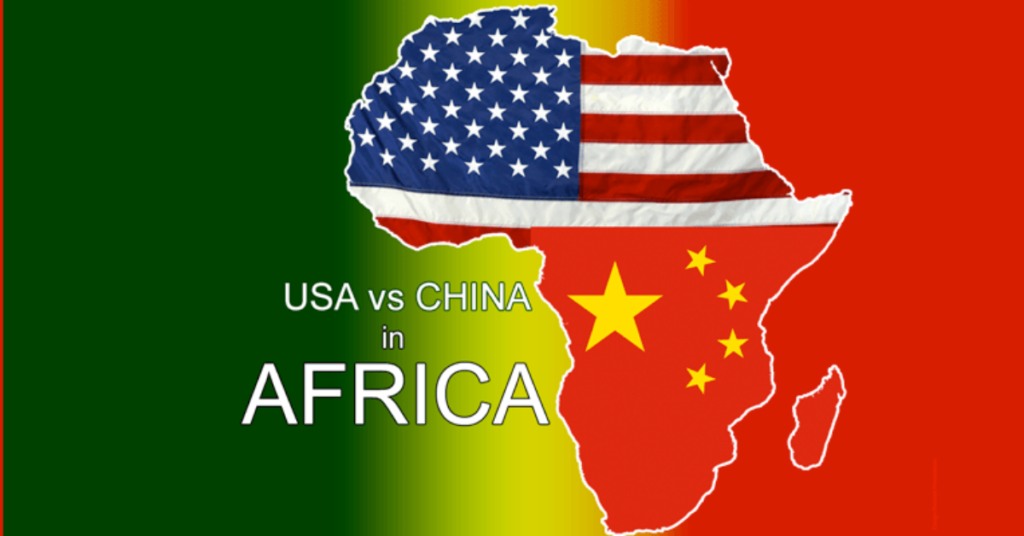The Middle Corridor, a pivotal project initiated by China has the potential to reshape the geo-political landscape significantly. While much attention has been devoted to China’s Belt and Road Initiative (BRI), the Middle Corridor remains relatively obscure despite its profound implications. In this article, we delve into the intricacies of the Middle Corridor, its stakeholders, and the geopolitical dynamics surrounding it.

Introduction
The Middle Corridor stands as China’s ambitious endeavor to establish a strategic trade route linking Asia to Europe. Encompassing nations like Kazakhstan, Azerbaijan, Turkey, and Georgia, this corridor holds the promise of altering existing trade dynamics and power structures in the Eurasian region.
Understanding the Middle Corridor
The Middle Corridor involves a consortium of nations with vested interests in bypassing traditional routes dominated by Russia. By fostering economic development and connectivity, it aims to diversify trade pathways and reduce dependence on existing corridors.

Stakeholders
The primary stakeholders in the Middle Corridor include China, Turkey, Kazakhstan, Azerbaijan, and Georgia. Each nation brings its strategic advantages and aspirations to the table, contributing to the corridor’s significance in global geopolitics.
Importance of Connectivity
Connectivity lies at the heart of the Middle Corridor, facilitating trade flows and fostering economic growth across participating nations. Improved infrastructure and logistical networks enhance accessibility and efficiency, driving regional integration and cooperation.
China’s Involvement
China’s partnership with Turkey underscores the significance of the Middle Corridor. Through strategic investments and alliances, China seeks to bolster its influence in key regions while countering geopolitical rivals such as the United States and Russia.

Geopolitical Implications
China’s involvement in the Middle Corridor reshapes geopolitical dynamics in the Eurasian region. By expanding its presence beyond traditional spheres of influence, China challenges established power structures and asserts its role as a global economic player.
Strategic Alliances
China’s collaboration with Turkey marks a strategic alignment aimed at diversifying trade routes and reducing dependency on existing corridors. By forging closer ties with Turkey, China gains access to crucial markets and resources, enhancing its economic resilience and geopolitical leverage.
The Northern Corridor vs. the Middle Corridor
A comparison between the Northern Corridor, historically dominated by Russia, and the emerging Middle Corridor elucidates the shifting tides of global trade. As China seeks alternative routes, traditional power dynamics face disruption, leading to a reconfiguration of trade patterns.
Impact on Trade Dynamics
The emergence of the Middle Corridor challenges Russia’s longstanding dominance over Eurasian trade routes. By providing an alternative pathway, it diversifies options for traders and reduces reliance on Russia-controlled corridors, thereby reshaping regional trade dynamics.
Geopolitical Shifts
The Middle Corridor’s rise signifies a broader geopolitical shift, with China and its allies seeking to assert influence beyond traditional spheres of control. This realignment poses challenges to established powers like Russia and prompts strategic recalibrations across the Eurasian region.
Challenges and Criticisms
Despite its potential, the Middle Corridor grapples with various challenges, including political disputes and logistical complexities. The presence of territorial conflicts and differing tariff structures poses hurdles to seamless integration and operational efficiency.
Political Disputes
Territorial disputes and regional conflicts pose significant challenges to the Middle Corridor’s viability. The unresolved conflicts between Azerbaijan and Armenia, for example, threaten to undermine regional stability and impede progress on infrastructure projects.
Logistical Complexities
The vast geographical expanse covered by the Middle Corridor presents logistical challenges, requiring extensive infrastructure development and coordination among participating nations. Overcoming these complexities is essential for realizing the corridor’s full potential and ensuring its long-term viability.
See More: Boeing 737 MAX Safety Under Scrutiny: FAA’s Audit Unveils Shocking Revelations
USA’s Perspective
The United States views the Middle Corridor as an opportunity to diminish Russia’s influence and expand its own presence in Central Asia. By leveraging the corridor’s economic prospects, the US aims to bolster its geopolitical position and access lucrative markets.

Strategic Interests
The Middle Corridor aligns with US strategic interests in countering Russian influence and promoting economic development in Central Asia. By supporting initiatives that diversify trade routes and reduce dependency on Russia, the US seeks to advance its geopolitical objectives in the region.
Economic Opportunities
The Middle Corridor offers lucrative economic opportunities for US businesses, providing access to emerging markets and facilitating trade partnerships with participating nations. By fostering closer ties with countries along the corridor, the US aims to enhance its economic engagement and geopolitical influence in the Eurasian region.
Implications for Russia and India
Russia stands to lose its dominance over Eurasian trade with the rise of the Middle Corridor. Additionally, India faces challenges in maintaining its strategic advantage in the Indian Ocean, where China’s influence threatens to undermine its interests.

Loss of Influence for Russia
The Middle Corridor undermines Russia’s longstanding dominance over Eurasian trade routes, posing a significant challenge to its geopolitical ambitions. By providing alternative pathways, it diminishes Russia’s control over regional trade flows and prompts strategic recalibrations across the Eurasian region.
Challenges for India
India’s strategic advantage in the Indian Ocean faces challenges from China’s expanding influence and presence in the region. As China strengthens its maritime capabilities and infrastructure projects, India must recalibrate its strategic priorities to safeguard its interests and maintain regional stability.
See More: Navigating Delays: The Future of Emirates Boeing 777X Fleet
Conclusion
In conclusion, the Middle Corridor represents a paradigm shift in global geopolitics, with far-reaching consequences for stakeholders across the Eurasian region. As China spearheads this ambitious initiative, the geopolitical landscape undergoes profound transformations, reshaping trade dynamics and power structures.
FAQs (Frequently Asked Questions)
- What is the Middle Corridor?
- The Middle Corridor is a strategic trade route initiated by China, connecting Asia to Europe through nations like Kazakhstan, Azerbaijan, Turkey, and Georgia.
- Why is the Middle Corridor significant?
- The Middle Corridor diversifies trade pathways, reduces dependence on traditional routes dominated by Russia, and fosters economic development in participating nations.
- What challenges does the Middle Corridor face?
- Political disputes, logistical complexities, and differing tariff structures pose hurdles to the seamless integration and operational efficiency of the Middle Corridor.
- How does the Middle Corridor impact global geopolitics?
- The Middle Corridor alters existing power dynamics by diminishing Russia’s influence, providing the United States with opportunities to expand its presence in Central Asia, and challenging India’s strategic advantage in the Indian Ocean.
- What are the future prospects of the Middle Corridor?
- The Middle Corridor holds the potential to reshape trade patterns and geopolitical alignments, with its long-term implications contingent on successful integration and overcoming existing challenges.
Thanks for Visiting Us In Focus!
For DMCA complaints, please visit our DMCA Form / Report Content
Follow us on other platforms as follows:
Facebook – https://www.facebook.com/usinfocus
X (formerly Twitter) – https://twitter.com/usinfocusdotcom


